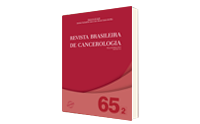Clinical Evolution and Predictors of Chemotherapy-Induced Peripheral Neuropathy
DOI:
https://doi.org/10.32635/2176-9745.RBC.2019v65n2.392Keywords:
Neoplasms, Peripheral Nervous System Diseases, Antineoplastic Agents, Neurotoxicity Syndromes, Drug TherapyAbstract
Introduction: Neurotoxic antineoplastic drugs are frequently associated to chemotherapy-induced peripheral neuropathy (CIPN). Objective: To evaluate the clinical evolution of patients exposed to potentially neurotoxic antineoplastic treatment and to identify possible clinical and sociodemographic predictors for the development of CIPN. Method: Cohort prospective study with patients with breast, ovary or intestine diagnosis of cancer in chemotherapy treatment with paclitaxel, docetaxel or oxaliplatin. They were assessed before the chemotherapy (T1), in the third month (T2) and 30-60 days after the interruption of the treatment (T3). All the patients responded to the questionnaire of clinical and sociodemographic profiles, were evaluated through neurologic clinical exam, by the performance scale ECOG, by the Hospital Anxiety and Depression Scale - HAD, pain scale of Short-cGuill, self-report of symptoms of CIPN and evaluation with the questionnaire of antineoplastic-induced neurotoxicity (QAIN). Results: Through self-report, 75% of the patients presented symptoms of CIPN. The QAIN showed that 90% presented a certain degree of CIPN in T2, while 82.5% still persisted in T3. Neuropathic pain affected 42% of the population (RR = 1.429, CI95% = 1.130 - 1.806). Anxiety and depression scores significantly reduced when compared with the beginning of the treatment (reduction of 2.5 points in the scale HAD, p < 0.05). The functional capacity of the population did not show any significant change. The school level was considered a predictor of self-report of CIPN symptoms in T2 (OR = 1.314, CI95% = 1.002-1.723, p = 0.048) p=0.048. Conclusion: The low school level may taint the patient capacity to report CIPN symptoms. This study draws attention for the necessity to use specific instruments for early detection of CIPN.









